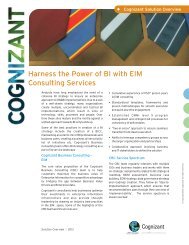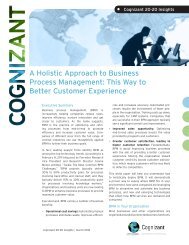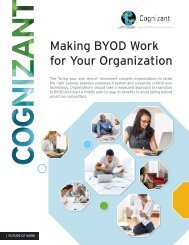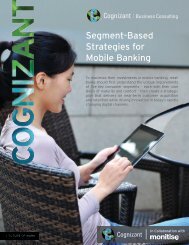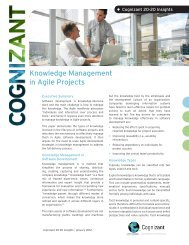Reflections - Cognizant
Reflections - Cognizant
Reflections - Cognizant
- No tags were found...
You also want an ePaper? Increase the reach of your titles
YUMPU automatically turns print PDFs into web optimized ePapers that Google loves.
It is important to understand that to realize the continuous innovation of a holistic BPO approach, theprovider needs to be able to equally address not just BPO -- which is by definition a people-centric business-- but also the systems and tools that support the processes and that can be leveraged across multipleprojects and engagements. This IT/BPO synergy is what fuels the cycle of innovation.This can be seen in the mortgage business optimization consultancy we did for a U.S. bank. The bank’smortgage lending division asked us to identify opportunities for process improvement, optimization,consolidation and cost reduction, with the goal of funding future growth initiatives. It asked us to developsolution options and a business case for key opportunity areas, as well as an implementation road map.We developed a synergistic strategy that uncovered approximately $18 million in savings over a three-yearbasis, spanning technology, sourcing, footprint and process optimization to continue increasing the client’smortgage lending leadership. Here is a summary of our recommendations:■ Technology: Implementation of upfront imaging to reduce printing/shipping costs by anestimated $1.25 million annually and serve as a prerequisite to leverage offshoringopportunities.■ Sourcing: Tap an estimated 100+ FTEs across regional processing centers, the wholesalelending business, the correspondent lending business, document control/post-closing andnew-loan setup. These activities have no voice-based client interactions, are relatively lowrisk, include a high degree of manual effort and are well-defined and repeatable.■ Process: Implement net funding for the retail channel and automate the construction/permanentdraw process. We also defined an incremental, high-level roadmap for the next four quarters tomitigate risk, minimize the people impact and factor in technology and consolidationdependencies.Measuring SuccessAchieving transformative ITO/BPO requires a radical rethinking of success metrics developed and used.Historically, we turn to service level agreements, such as completing a certain number of transactions in agiven timeframe or achieving a set level of uptime. But those metrics do not always accurately reflectwhether a business has achieved its goals.It’s essential, before entering into a BPOrelationship, for the client and the providerto understand how to measure success, whichentails knowing the business outcomes youwish to accomplish and devising metrics thatare in line with those events.A better way to measure success is by establishing the business outcomes that the company wants toaccomplish and then devising metrics based on those outcomes. What outcome is really going to impact thebusiness? Rather than measuring how long it took to enter data in a form or process a transaction, shouldn’twe be asking whether we’ve lowered the cost of originating a mortgage or boosted customer satisfaction?Consider a mortgage business that chooses to outsource its loan origination process with the goal oflowering the cost per loan, boosting customer satisfaction, and increasing both the quality and volume ofloans originated. If service level metrics are based on measures such as 24-hour turnaround time in 95%of the cases, how does that matter to the ultimate business goals? Are we sure that faster loan originationdrives down cost, increases loan quality, or brings in more business? It would be more important to knowhttp://cognizant.com REFLECTIONS 14




